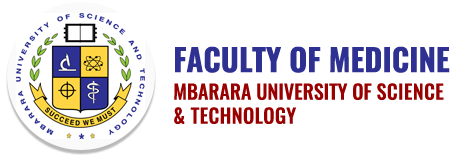
Crispin Duncan Sesaazi
Senior Lecturer- HOD
Pharmaceutical Science
Phone: 0772415428
Senior Lecturer
The research interests of Dr Duncan Sesaazi include the isolation, identification, and biological evaluation of compounds from higher plant and microbial origin, particular compounds useful as chemotherapeutic agents, from endophytic fungi. Currently, Dr Sesaazi is researching on the ethnopharmacological and traditional medicinal uses of Morinda citrifolia (Noni) (which is done in collaboration with Daniel K. Inouye College of Pharmacy at the University of Hawaii at Hilo, USA) and Annona muricata. In both cases, endophytic fungi are being isolated from the fruits and then evaluate their cancer chemopreventive properties The identification of some of the bioactive lead compounds from Stemphylium solani, an endophyte that was isolated from the fruit of Morinda citrifolia is under way.
Training
Dr Duncan Sesaazi has trained and acquired knowledge and technical expertise pertaining to the structural elucidation of natural products and drug discovery from higher plants and fungal sources. The techniques he acquired include the following:
Cell culture including the culture of human cancer cell lines
Bioassays to determine cellular toxicity and anticancer activity
Basic microbial techniques used in the culture and propagation of endophytic fungi
The organic extraction of secondary metabolites from plants and fungal cultures
Medium Pressure Liquid Chromatography (MPLC) separations and analyses of extracts from plants and fungal cultures
High Performance Liquid Chromatography (HPLC) separations and analyses of plants and fungal extracts
Nuclear Magnetic Resonance (NMR) Spectroscopy – both 1D (1H and 13C) and 2D (COSY, NOESY, HSQC, etc. )
Infrared spectrophotometry
Liquid chromatography-Mass Spectroscopy (LC-MS)
Education
M.Sc., Natural Products Chemistry, Makerere University, Kampala, Uganda
PhD, Phytochemistry, Mbarara University of Science and Technology, Mbarara, Uganda.
Classes and Courses
BPS 2103 Non-Instrumental Methods of Analysis
BPS 2103 Pharmaceutical Chemistry I
BPS 2203 Instrumental Drug Analysis
BPS 2204 Medicinal Chemistry
BPS 3105 Proposal Development and Writing
Responsibilities
Head of Department of Pharmaceutical Sciences (MUST)
Member of Quality Assurance Committee, Faculty of Medicine, MUST
Selected Presentations and/or Publications
Int. J. Curr. Microbiol. App. Sci (2015) 4(6): 696-707
Phytochemical Society of North America (2011), Hawaii, USA
.J.Curr.Microbiol.App.Sci (2015) 4(6): 696-707
International Journal of Current Microbiology and applied Sciences
ISSN: 2319-7706 Volume 4 Number 6 (2015) pp. 696-707
http://www.ijcmas.com
Original Research Article
Comparison of Antibacterial Activities of Fermented with those of Unfermented Annona muricata (L) Fruit Extracts
Robert B. D. Otto1*, Maureen Nankwanga2 and Duncan Sesaazi2
1Unit of Pharmaceutical Microbiology and Biologicals Studies, Department of Pharmacy, School of Health Sciences, College of Health Sciences, Makerere University, P.O. Box 7072, Kampala, Uganda 2 Department of Pharmacy, Faculty of Medicine, Mbarara University of Science and Technology, Mbarara, Uganda
*Corresponding author
A B S T R A C T
Fermentation is known to enhance the antibacterial activities of some plant products. The research aimed to compare the antibacterial activities of the fermented with those of unfermented fruits of Annona muricata, obtained from eastern Uganda. Ripe fruits were blended wholly and fermented for a period of one week, immediately after; fresh ripe fruits were blended in the same way. Cold maceration for extraction were used on the fermented and unfermented blends to obtain hexane, ethyl acetate and methanol extracts, which were tested against standard strains of Escherichia Coli (ATCC 25922), Pseudomonas aeruginosa (ATCC 27853), Staphylococcus aureus(ATCC 25923)and Streptococcus pyogenes (ATCC 19615), using modified agar diffusion technique. The micro-dilution method was applied for the determination of the minimal inhibitory concentrations (MICs). With the exception of hexane extracts, all the other extracts inhibited the growth of all the bacteria, but the corresponding fermented extracts inhibited greater. The study showed both the fermented and unfermented fruits of Annona muricata have antibacterial activity against both gram negative and gram positive bacteria, but the potency is higher with the fermented fruits.
Introduction
The growing resistance of microorganisms to conventional antibiotics is becoming a serious concern to microbiologists and health care practitioners all over the world. As a result, efforts are being made to develop antimicrobial agents from local sources for better chemotherapeutic effect but with less adverse effects (Oyeleke et al., 2008; Ismail et al., 2011). With increasing realization of the health hazards and toxicity associated with the indiscriminate use of synthetic drugs and antibiotics, interest in the use of biogenic drugs has revived throughout the world (Nalawadeet al., 2003).There is therefore a general call for newer antimicrobial agents that possess low adverse effects (Oyeleke et al., 2008; Ismail
et al., 2011).With increasing realization of the health hazards and toxicity associated with the indiscriminate use of synthetic drugs and antibiotics, interest in the use of biogenic drugs has revived throughout the world (Nalawadeet al., 2003).There is therefore a general call for newer antimicrobial agents that possess low
ISSN: 2319-7706 Volume 4 Number 6 (2015) pp. 696-707 http://www.ijcmas.com
Fermentation is known to enhance antibacterial activities of some plant products. The research aimed to compare the antibacterial activities of the fermented with those of unfermented fruits of Annona muricata, obtained from eastern Uganda. Ripe fruits were blended wholly and fermented for a period of one week, immediately after; fresh ripe fruits were blended in the same way. Cold maceration for extraction were used on the fermented and unfermented blends to obtain hexane, ethyl acetate and methanol extracts, which were tested against standard strains of Escherichia Coli (ATCC 25922), Pseudomonas aeruginosa (ATCC 27853), Staphylococcus aureus(ATCC 25923)and Streptococcus pyogenes (ATCC 19615), using modified agar diffusion technique. The micro-dilution method was applied for the determination of the minimal inhibitory concentrations (MICs). With the exception of hexane extracts, all the other extracts inhibited the growth of all the bacteria, but the corresponding fermented extracts inhibited greater. The study showed both the fermented and unfermented fruits of Annona muricata have antibacterial activity against both gram negative and gram positive bacteria, but the potency is higher with the fermented fruits.
Abstract #450
The cytotoxic constituents of Stemphylium solani, a fungal endophyte of Morinda citrifolia L. (noni). Crispin D. Sesaazi1,4, Anthony D. Wright1, Sisay Girmay1, Chad Higa2, Fred M. Sebisubi3, Jasper Ogwal-Okeng4, Brian Perry2 and Ghee T. Tan1. 1Department of Pharmaceutical Sciences, College of Pharmacy and 2Department of Biology, University of Hawaii at Hilo, Hilo, HI, USA; 3Division of Pharmaceutical Services, Ministry of Health, Kampala, Uganda; 4Department of Pharmacology and Therapeutics, Makerere University, Kampala, Uganda.
Morinda citrifolia L. (noni) (Rubiaceae) is a popular medicinal plant indigenous to many pan-tropical regions of the world. The juice from the fermentation of its fruits is claimed to have anticancer properties, but this has remained largely unverified under rigorous pharmacological criteria. The present study investigated the anticancer potential of the metabolites of Stemphylium solani (Ascomycota), an endophytic fungus isolated from the leaves of the noni plant. S. solani was identified during the screening of 30 pure endophyte isolates from the fruits and leaves of noni for cytotoxic activity. The total ethyl acetate extract of 5-week old malt extract fermentation broth cultures demonstrated IC50 values of 5 and 7 µg/mL against human lung carcinoma (LU-1) and human prostate carcinoma (LNCaP) cell lines, respectively. Bioassay-guided flash chromatography of the total extract yielded several major cytotoxic fractions. Preliminary purification of one of these fractions using MPLC and reverse phase semipreparative HPLC led to the isolation of two cytotoxic compounds whose structures are being determined by state-of-the-art techniques. Since S. solani is not known to be pathogenic to noni, these cytotoxic constituents may be the product of symbiotic interactions between the fungal endophyte and its host plant. Such cryptic metabolic contributions could conceivably play a role in the purported usefulness of noni in the management of a variety of diseases including cancer.
Keywords: Morinda citrifolia, noni, Stemphylium, endophyte, fungus, cytotoxicity.
ABSTRACT
IntDepartment of Pharmaceutical Sciences, College of Pharmacy, University of Hawaii at Hilo, Hilo, HI, USA 2Department of Biology, University of Hawaii at Hilo, Hilo, HI, USA 3Division of Pharmaceutical Services, Ministry of Health, Kampala, Uganda 4Department of Pharmacy, Mbarara University of Science and Technology, Mbarara, Uganda 5Department of Pharmacology and Therapeutics, Makerere University, Kampala, Uganda. Morinda citrifolia L. (noni) (Rubiaceae) is a popular medicinal plant indigenous to many pan-tropical regions of the world. Juice from fermentation of its fruits is claimed to have anticancer properties, but this has remained largely unverified under rigorous pharmacological criteria. The present study investigated the anticancer and antioxidant potential of metabolites isolated from Stemphylium solani (Ascomycota), an endophytic fungus isolated from the leaves of the noni plant. S. solani was identified during the screening of 30 pure endophyte isolates from the fruits and leaves of noni for their cytotoxic activity. The total ethyl acetate extract of a 5-week old malt extract broth (MEB) culture of the fungus demonstrated IC50 values of 5 and 7 μg/mL against human lung carcinoma (LU-1) and human prostate carcinoma (LNCaP) cell lines, respectively. By means of repeated chromatography over silica gel, preparative TLC, MPLC, HPLC and flash chromatography guided by cytotoxicity and antibacterial activity, several compounds were isolated, four of which were positively identified. These compounds were 7-hydroxy-2-(2’hydroxypropyl)-5-methylchromone (1), 1,7-dihydroxy-3-methoxy-6-methylanthracene-9,10-dione (Macrosporin, 2), 1-hydroxy3,7-dimethoxy-6-methylanthracene-9,10-dione (Macrosporin 3-methyl ether, 3), and 2,3,5-trihydroxy-7-methoxy-2methylanthracene-9,10-dione (Altersolanol B, 4). For compounds 1-3 we report the first complete unambiguous fully assigned 1H and 13C NMR data, and for 4 the first complete unambiguous fully assigned 1H NMR data. Since S. solani is not known to be pathogenic to noni, these bioactive constituents may be the product of symbiotic interactions between the fungal endophyte and its host plant. Such cryptic metabolic contributions could conceivably play a role in the purported usefulness of noni in the management of a variety of diseases including cancer.
HMBC Spectrum of 1 (400 MHz, CD3OD)
NOESY Spectrum of 1 (400 MHz, CD3OD)
Stemphylium solani malt extract broth culture (3.5 L)
Mycelia (117 g)
Filtration
EtOAc Extract
EtOAc 3 X 500 mL
Spent Broth
EtOAc 1 X 500 mL
n - BuOH 3 X 500 mL
n -BuOH Extract (0.63 g)
Water wash (1.63 g)
Hexane 3 X 500 mL
n -Hexane Extract (0.69 g)
EtOAc Extract (4.72 g)
Stemphylium solani MEB culture extraction scheme
Stemphylium solani EtOAc extract (3.84 g)
Batch 1 (2.5 g) Batch 2 (1.0 g)
Prep-HPLC 20 % to 80 % MeOH in 0.01 % TFA/H 2 O
Open column chromatography (SiO2) Hexane/ EtOAc gradient EtOAc / MeOH gradient
II Flash chromatography (SiO2) C 6 H 14 /EtOAc 9 : 1
Macrosporin methyl ether, 3 (11.3 mg, 0.45%) 1-hydroxy-3,7-dimethoxy-6methylanthracene-9,10-dione
IV 1. HPLC Reverse phase 20 to 80% MeOH in 0.01% TFA/H 2 O 2. MPLC CHCl 3 /MeOH 4:1
Macrosporin, 2 (30.2 mg, 1.2%) 1,7-dihydroxy-3-methoxy-6methylanthracene-9,10-dione
VIII 1. MPLC EtOAc / MeOH (100:0 to 0:100) 2. Prep-TLC CHCl 3 / MeOH 1:4
Compound 1 (7.0 mg, 0.3%) 7-hydroxy-2-(2'-hydroxypropyl)5-methylchromone
XVIII 1. SemiprepHPLC 20% to 80% MeOH in 0.01% TFA/H 2 O 2. SemiprepHPLC 20% to 80% MeOH in 0.01% TFA/ H 2 O Altersolanol B, 4 (4.0 mg, 0.4%) 2,3,5-trihydroxy-7-methoxy-2methylanthracene-9,10-dione
Cytotoxicity
